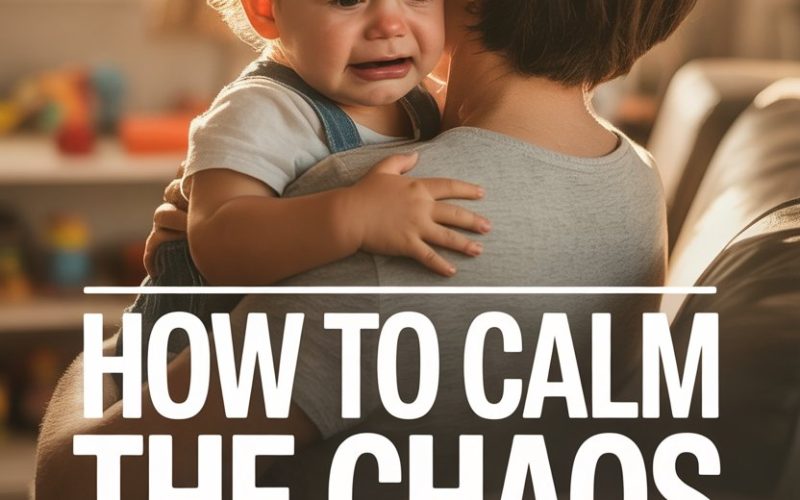Ever been serenaded by a wailing child at 3am, certain you must be starring in a gritty parenting reboot of “Les Misérables”?
If your little one seems to have a PhD in crying — and you’re running on coffee fumes and wild hope — you’re far from alone.
Let’s talk about calming the storm (and your nerves) when your child’s tears just won’t quit.
When You’re Caught in the Eye of the Storm
Nobody tells you that parenthood might involve being screamed at by someone in Spiderman pajamas because their banana broke in half.
Nonstop crying can unravel even the most unflappable adults, and busy parents simply don’t have hours to spend dissecting every wail.
Before you set up camp in the laundry cupboard (tempting as it is), take a breath. There’s a method to this madness.
Why the Tears Happen
Babies cry. Toddlers cry. School-aged kids cry in surround-sound Dolby Digital.
Crying is how children signal that something is wrong — hunger, tiredness, frustration, discomfort, confusion, fear, a vague sense that their sock feels “funny.”
The trick is, as a study from Harvard’s Center on the Developing Child points out, young brains are still learning to regulate emotion. Crying is a top tool in the arsenal.
Older children might cry for reasons that feel less dire to you, but are genuinely huge in their world — an argument with a friend, a lost toy, or the sheer injustice of broccoli.
Keep Your Own Cool (Easier Said Than Done)
If you’re feeling your blood pressure rise, that’s completely normal. When your child’s wails hit a certain decibel, your own nervous system jumps into fight-or-flight mode — thank evolution for that.
Dr. Laura Markham, clinical psychologist and author of Peaceful Parent, Happy Kids, encourages parents to notice their own physical cues: tight jaw, clenched fists, sudden urge to hide under the duvet.
When you sense your patience evaporating, try this: take three slow breaths, unclench your fists, and say nothing for a couple of seconds.
Sometimes, your own calm is the anchor everyone needs.
Basic Needs Check: The Usual Suspects
Start with the classics. Is your child hungry? Thirsty? Too hot or cold? Sitting on their leg in a way that’s cut off circulation?
All the clever parenting advice in the world won’t help if the problem is a forgotten snack.
Parents often call it the HALT method (Hungry, Angry, Lonely, Tired). Go through this mental checklist. Children are masters at melting down over basic needs.
If none of these seem to apply, proceed to the next layer of the onion.
Give the Crying Some Space (Yes, Really)
The instinct to hush a crying child is universal. But sometimes, a little space to vent emotion can work wonders.
According to psychologist Dr. Aletha Solter, acknowledging the feeling (“That was a tough fall, and it really hurt”) has a magical way of helping the crying pass more quickly.
Rather than shushing, try being present. Hold them or sit next to them. Show you’re there, but don’t rush to “fix” it straight away. Oddly enough, this can actually slow the tears.
Offer Comfort Through Touch and Presence
Some kids need a cuddle; others want to sit quietly nearby. Physical touch — a hand on the shoulder, a gentle rub on the back — can signal safety.
Research from the Touch Research Institute shows that affectionate touch lowers cortisol (that stress hormone that makes us want to eat a pack of biscuits in the pantry).
For some children, especially the more independent types, sitting nearby in companionable silence can be just as soothing. The key is tuning in to what your particular child finds comforting.
Name the Feeling
Imagine having a tidal wave of emotion but no words to explain it — that’s a Tuesday afternoon for most little ones.
Naming the feeling (“You sound really frustrated that your block tower fell down”) helps children begin to make sense of their emotional world.
According to Dr. Daniel Siegel, author of The Whole-Brain Child, “name it to tame it” can actually help a child’s brain process distress.
Even older kids benefit from this. “You’re upset because your friend didn’t want to play — is that right?”
It’s amazing how just feeling understood can take the edge off, even if the situation remains unchanged.
Distraction: The Oldest Trick in the Book
It’s not bribery. It’s creative parenting.
Sometimes, especially for toddlers, a well-timed change of scene can work wonders: “Shall we see what’s in the fridge for snack?” or “Look, a pigeon!” (Honestly, no shame in using urban wildlife.)
For older children, distraction might mean suggesting a quick game, putting on some music, or offering an art activity.
The idea isn’t to pretend the feelings don’t matter, but to break the cycle of distress long enough for calm to return.
Let the Tears Flow (Within Reason)
Not every cry needs to be cut short. Tears can be cathartic, a way for children to release pent-up stress.
Allowing a child to have a good cry every now and then isn’t a sign you’re failing — it can actually help them learn resilience.
If the tears seem to be genuine grief or sadness, simply being there is enough. Your presence teaches that big feelings aren’t dangerous, and that it’s safe to feel them.
When Your Child Can’t Calm Down
After the basics are covered (food, drink, comfort), and you’ve acknowledged feelings, some children still can’t settle.
This might be meltdown territory — when the emotional system is overloaded and logic has left the building.
During a meltdown, conversation often makes things worse. Try removing sources of stimulation (turn down the lights, lower your own voice, reduce background noise).
Think of it as making the world just a little gentler while they weather the storm.
Keep them safe, stay nearby, and wait. This phase doesn’t last forever, even if it feels like time stopped somewhere around the fifth sob.
Practical Calming Techniques to Try Tonight
Certain tricks can help children reset:
- Have a “calm corner” — a cosy spot with cushions, books, or favourite soft toys.
- Try breathing together. Young children respond well to blowing bubbles or pretending to blow out birthday candles.
- Offer a drink of water. Sipping can be surprisingly grounding.
- For older children, suggest a walk outside, listening to music, or doodling their feelings on paper.
Trial and error plays a big role here. Every child is different, and what works on Tuesday may be met with outrage on Wednesday.
Routine is Your Friend
Children love predictability, even if they claim otherwise. If tears are cropping up at the same time each day (hello, witching hour), consider whether you can tweak your routine.
Maybe an earlier snack, a longer cuddle at bedtime, or a gentler wind-down routine.
Visual schedules — a simple chart with pictures showing what comes next — can help younger children feel more secure and less prone to tears.
When to Worry (and When Not To)
Most of the time, crying is just a sign your child is a full-blooded human. Still, trust your gut.
If your child’s tears are accompanied by fever, rash, lethargy, or seem completely out of character, check in with your GP or paediatrician.
If crying is chronic, happens with every transition, or you sense there’s more going on emotionally, reaching out to a child psychologist can be enormously helpful.
Sometimes, all parents need is reassurance; sometimes, a little extra support is the ticket.
Self-Care Isn’t Just a Buzzword
Constant crying can leave any parent feeling like a wrung-out dishcloth. Make sure you’re caring for yourself as well.
Tag-team with a partner if you can, or ask a neighbour or friend to take over for ten minutes while you step outside and breathe.
No medals are handed out for martyrdom. Your own calm is contagious, and it’s much easier to keep your cool when you’ve had a moment to regroup.
When All Else Fails
Some days, nothing works. Children are not machines; they have off-days, just like adults.
If you need to step away to keep your cool, it’s okay to put your baby safely in their cot or your child in a secure spot and take a breather.
Parenting is a marathon, not a sprint — and sometimes, a sprint to the bathroom for a moment of silence is exactly what you need.
Small Victories Count
The next time a wailing session begins, remember: you’re not alone, you’re not inept, and this phase will eventually pass (even if it doesn’t feel like it at 2:17am).
Each moment you weather with empathy and a dash of patience lays the groundwork for your child’s emotional resilience — and for your own, too.
Now, go ahead and pat yourself on the back.
Or, if you’re lucky, pour a cuppa while the silence lasts. That’s called winning at parenting.





